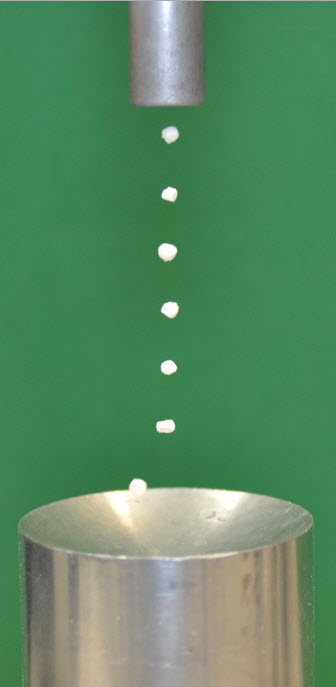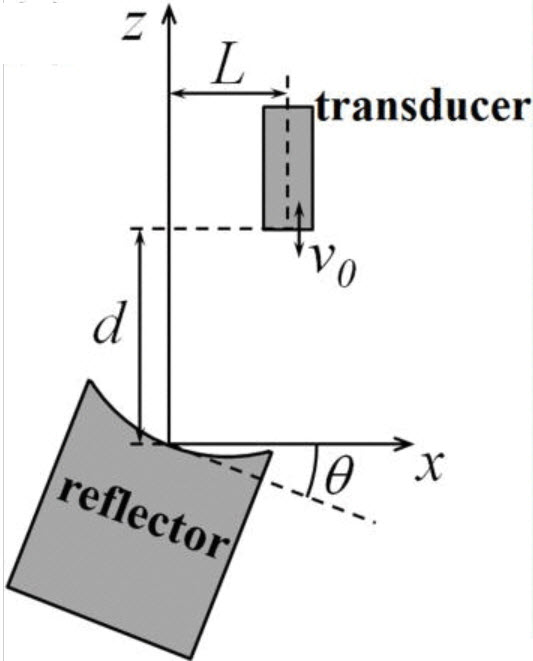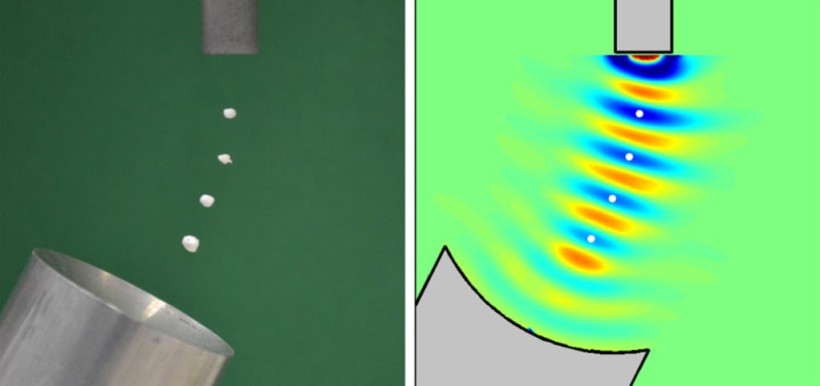Precisely controllable acoustic levitation
January 7, 2015

Controlled levitation of expanded polystyrene particles by ultrasonic sound waves (credit: M. Andrade/University of São Paulo)
University of São Paulo researchers have developed a new levitation device that can hover a tiny object with more control than was previously possible.
Featured on this week’s cover of the journal Applied Physics Letters in an open-access paper, the device can levitate polystyrene particles by reflecting sound waves from a source off a concave reflector below.
Changing the orientation of the reflector also allows the hovering particle to be moved around.
Other researchers have built similar devices in the past, but they always required a precise setup where the sound source and reflector were at fixed “resonant” distances. This made controlling the levitating objects difficult.
The new device shows that it is possible to build a “non-resonant” levitation device — one that does not require a fixed separation distance between the source and the reflector.
This breakthrough may be an important step toward building larger devices that could be used to handle hazardous materials or chemically sensitive materials like pharmaceuticals, to move parts between robots on assembly lines — or even to provide technology for a new generation of high-tech, gee-whiz children’s toys.
The researchers tested the device with polystyrene blobs about 3 mm across. The next step is to improve the device to levitate heavier materials,” said Marco Aurélio Brizzotti Andrade, who led the research.
How it works

Schematic diagram of the new acoustic levitator (credit: M. Andrade/University of São Paulo)
Recently, there has been significant progress in the manipulation of small particles by acoustic levitation methods. In a typical setup, an upper cylinder will emit high-frequency sound waves that, when they hit the concave part of the device at the bottom, are reflected back.
The reflected waves interact with newly emitted waves, producing what are known as standing waves, which have minimum acoustic pressure points (or nodes), and if the acoustical pressure at these nodes is strong enough, it can counteract the force of gravity and allow an object to float.
The first successful acoustical levitators could successfully trap small particles in a fixed position, but new advances in the past year or so have allowed researchers to also transport particles through short distances in space.
However, the distance between the sound emitter and the reflector had to be carefully calibrated to achieve resonance before any levitation could occur (the separation distance had to be equal to a multiple of the half-wavelength of the sound waves).
If this separation distance were changed even slightly, the standing wave pattern would be destroyed and the levitation would be lost.

Levitation of expanded polystyrene particles (left) and the corresponding simulated standing-wave pattern (credit: M. Andrade/University of São Paulo)
To improve the design, the researchers used a numerical model to calculate the acoustic pressure distribution and a theory by Lev Gor’kov to obtain the potential acoustic radiation force acting on a levitated particle.
With the new levitation device, the distance between the sound emitter and the reflector can be continually changed without affecting the levitation performance at all, Andrade said. They also demonstrated that levitating particles can be manipulated by controlling the reflector position while maintaining the transducer in a fixed position.
Abstract for Particle manipulation by a non-resonant acoustic levitator
We present the analysis of a non-resonant acoustic levitator, formed by an ultrasonic transducer and a concave reflector. In contrast to traditional levitators, the geometry presented herein does not require the separation distance between the transducer and the reflector to be a multiple of half wavelength. The levitator behavior is numerically predicted by applying a numerical model to calculate the acoustic pressure distribution and the Gor’kov theory to obtain the potential of the acoustic radiation force that acts on a levitated particle. We also demonstrate that levitating particles can be manipulated by controlling the reflector position while maintaining the transducer in a fixed position.